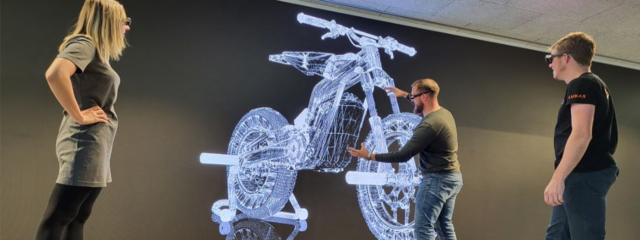
Extended Reality im Schumpeter Labor für Innovation
Throughout the last year the Schumpeter Laboratory for Innovation was expanded with the integration of Extended Reality (XR) equipment. In recent years extended reality has made the transition from an emerging technology to being used for various applications in industry and research. XR and its subfields Augmented Reality (AR) and Virtual Reality (VR) allow users to interact with virtual environments in new ways and provide new possibilities for product development, education, and training.
Equipment
Within the SLFI a wide range of equipment is now available. Various Head Mounted Devices like the Meta Quest 2 and the Microsoft HoloLens 2 allow to enter fully virtual environments or augment the real world. Additionally, peripheral equipment allows to experience haptic feedback, as well as enable natural movement in the virtual environment. The previously existing LED Wall in the Design Lab of the Schumpeter Laboratory for Innovation was upgraded with 3D functionality, making it a 30m² Powerwall that allows up to 100 users at the same time to experience 3-dimensional content.
Applications
Several applications and use cases have already been developed and are continuously developed further. The XR basics module, where participants learn both theoretical as well as practical knowledge about the application and usage of XR HMDs, acts as the base for further modules. These include a virtual design review throughout a product development process, as well as a virtual tear-down lab and a training scenario in a fully virtual learning factory (on the example of the institute’s LEAD factory). The advantage of XR technology is its ability to enhance the learning experience in several measures, for example by enabling participants to interact with virtual models of their creations, thus not only improving their understanding but also making learning more engaging and exciting.
Research
Ongoing research is currently being conducted on the topic of implementing XR in makerspaces – especially regarding potentials, benefits, and barriers. The aim is to identify and evaluate the potential of XR to support functions and processes that are typical for makerspaces. The first research results have already been presented during the International Symposium on Academic Makerspaces (ISAM) 2022 and the Conference on Learning Factories (CLF) 2023.
Outlook
Throughout the upcoming months, the infrastructure and applications will further be upgraded. The integration in university courses has already been partially completed and will be further advanced. In addition, the infrastructure can now also be used for various use cases - for example, visualization of layout projects - within the framework of industry cooperations.
- Research Project 'Transform.Industry'
- Extended Reality im Schumpeter Labor für Innovation
- Successful completion of several industrial projects
- Maker, Industry and Research #3 – Project kickoff
- Review of two years of IALF presidency
- SpInnovation - from Invention to Business
- Alumni Reunion 2023
- Innovation Gala 2023
